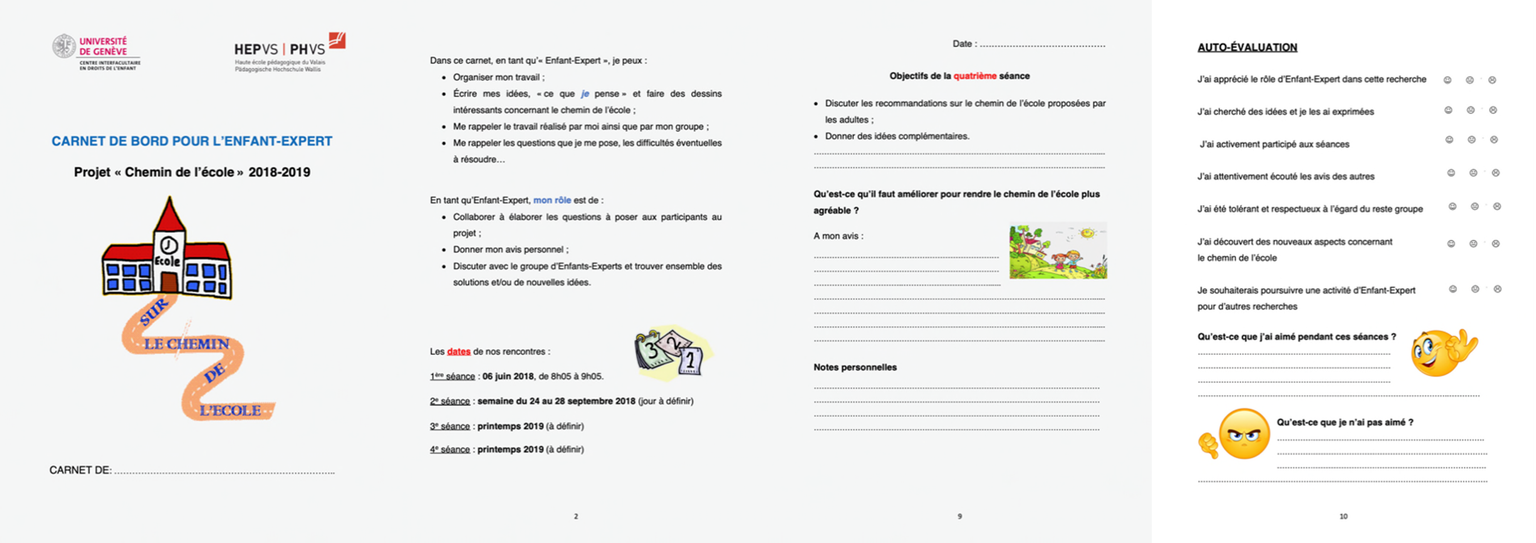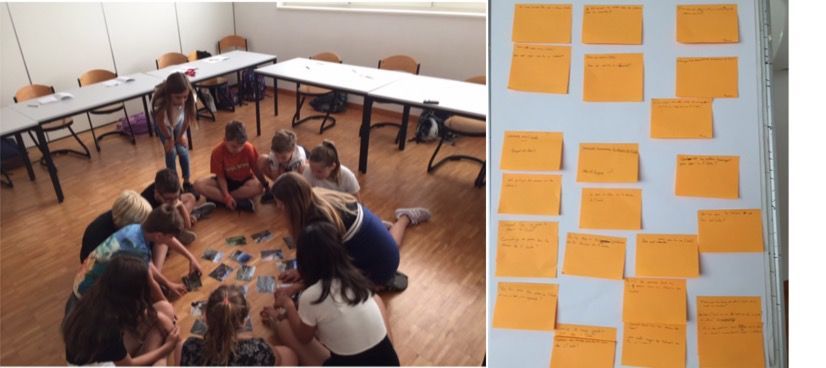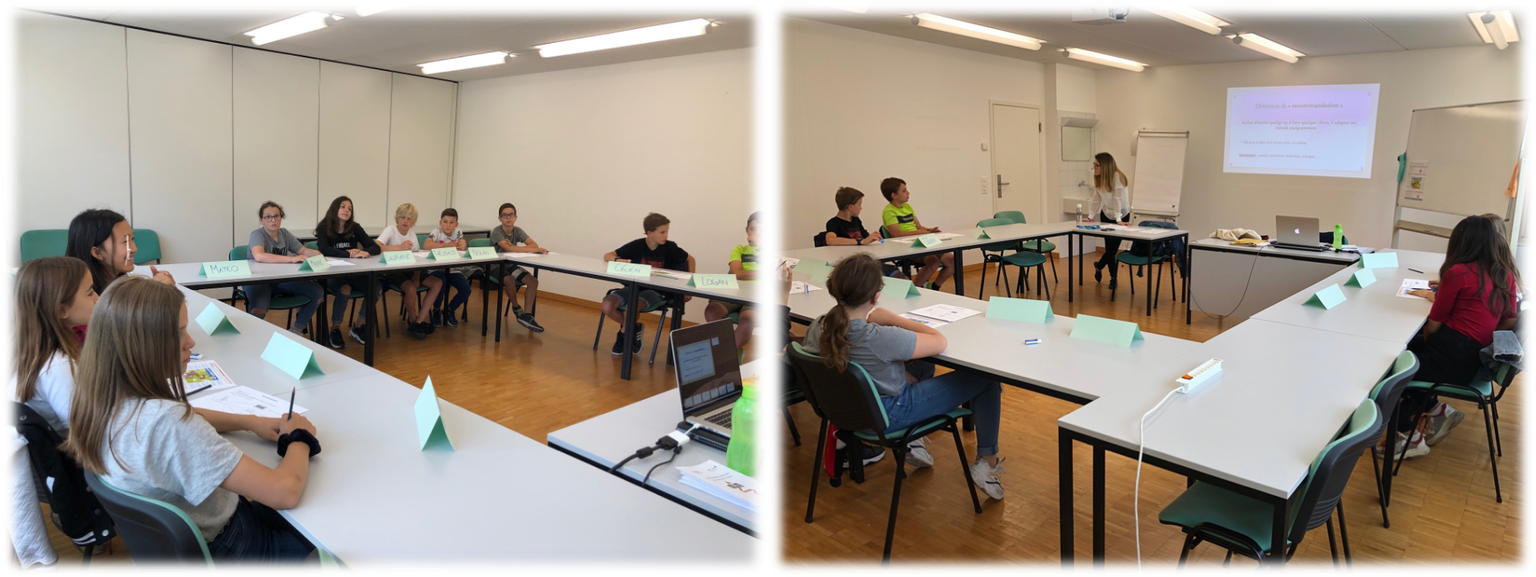Children as co-researchers in a stakeholder discussion group
Context
This transdisciplinary methodological tool was developed and implemented as part of the Swiss National Science Foundation (SNSF) research project «Exploring the way to and from school with children: an interdisciplinary approach of children’s experiences of the third place» (2017-2021), n° CR11I1_166050. Team: Zoe Moody (HEP-VS & UNIGE) – Principal applicant, Philip D. Jaffé (UNIGE) & Frédéric Darbellay (UNIGE) – Co-applicants. Ayuko Berchtold-Sedooka (HEP-VS & UNIGE) – Senior Research Associate & Sara Camponovo (HEP-VS & UNIGE) – Phd Researcher.
Purpose
Engaging with “Children as co-researchers” is an intermediate way of involving children in research; conducting research with and by children. A group of children researchers external to the research sample is involved in the research project to assist in refining the methodological tools and the questions. The group is also involved in analysing the data: tools are co-produced by and for the children to help them organize and examine the data. Furthermore, they are involved in co-writing of recommendations to civil society. This approach makes it possible to systematically incorporate children’s views on issues of direct interest to them and for which they are the primary experts during the whole course of the research project. In the context of the td-net toolbox, it may be considered as a special form of a multi-stakeholder discussion group, adapted to the specificities of children as co-researchers.
Process
Ethically, it is preferable to limit the number of exclusion of children interested in participating in the project. Therefore, we decided not to recruit children too broadly at first. We contacted one school, within walking distance from the university, to facilitate children’s venue to the working sessions. We presented the project and its pedagogical aims to the school principal and to one teacher who acted as gate keeper. The aim was to limit the time the children would have to dedicate to the project, we thus agreed that children’s participation would take place during school time.
The teacher outlined the study to the children in her class, based on the child friendly information we provided. To ensure active involvement of all participants and to provide enough space for everyone to freely express their views, the decision was taken to limit the number of co-researchers to ten. Children’s parents/legal guardians were sent an information sheet and consent form outlining the objectives of the research and ethical procedures. The children were also asked to sign the consent form to confirm their agreement. At the start of each session, children were again given information about the study and their right to withdraw at any time from the process, without negative consequences (Morrow, 2008).
We organized four sessions in the course of ca. 18 months aiming at 1) Finalising child-friendly tools and research questions, 2) First inspection of data, 3) Data analysis, 4) Drafting recommendations.
Session format
The sessions involved 10 children moderated by an adult facilitator who led the sessions and an adult observer who helped children and took notes and photos.
The methodology of these sessions is anchored in a child-friendly approach: time management; choice of comfortable place; playful and creative style of activities, etc. Each working session lasted ca. 45 minutes. The sessions took place outside the school building where the children usually go, so as not to replicate the context of the school classroom. During the sessions, different forms and contents of activities were utilised: plenary group activities, small working-groups (3-6 members), in pairs and individually; presentation to others, group discussion, drawing, writing, etc.
To align the sessions with the objectives of the project, each child was given a “Carnet de bord pour l’enfant-expert (research note)” in which he or she was free to note his or her opinions and remarks at the end of each session.

Session I: Finalizing child-friendly tools and research questions
The main objective was to create a good working environment for free exchange within the group, as well as for effective collaboration between children and adults, by reducing the power imbalance.
- We started with a playful self-introduction activity (ball tossing game to stimulate exchanges, etc.).
- The aims were to select 12 photos to be used later in the fieldwork and to formulate the questions to ask to other children who will be interviewed.

Session II: First inspection of drawings/data
The main objective was to conduct the first data analysis.
- Group activity: Child researchers sat in circles and one adult researcher showed one drawing produced by the research participants during the fieldwork at a time. Each child was free to comment the drawings.
- Then, each drawing was placed on a table. The child researchers were free to choose the drawing(s) they are most interested in and to write on the post-it notes the question(s) they would like to ask the ‘drawers’.

Session III: Data analysis
The main objective was to discover, interpret and discuss the first results of the research.
The session began with a group activity. The adult researcher first reported the initial findings, then carried out a group-discussion with the child researchers.
Child researchers worked in pairs to analyse some aspects of the data, along co-defined analysis axes (suggested by the research team and supplemented by the child researchers’ suggestions). They answered some generic questions and presented their findings to the group. Each pair received three research results and compared them according to the following axes of analysis: a) similitude or difference in position of photographs according to the different contexts (urban, peri-urban and mountain); b) similar or different comments (positive and negative) for image ranking and c) key arguments of participants.
Session IV: Drafting recommendations
The aim was to define the recommendations to be delivered to the civil society to improve children’s daily lives.
- The session began with work in pairs. Each pair wrote three recommendations: one general and two on a specific issue; some recommendations were directed to the parents, others to the school.
- Each pair of child researchers shared its outcomes with the group.

Lessons learnt
- For organisational reasons, it might be easier to create a group of children in the same age range (e.g. 10-12 years old). However, more heterogenous groups can also provide broader perspectives on the whole process.
- If the children come from the same school, class, sport group or quarter, knowing each other prior to getting involved in the project (even if participating for the first time in a research project) can contribute to creating a sense of belonging in the group, and influence the outcomes positively. In addition, for children being part of a group that is numerically superior to that of adults contributes to reduce power issues.
- At times, children find it difficult to put aside their own experience and to think more general, especially when they have to compare data (session III). Using more general words, e.g. ‘everyone’, ‘several children’, may help children to think beyond the immediate circumstances or specific experiences.
- The participation of this group is not supported by educational benefits, even if these allow children to learn new skills too, but it must be understood as a worthwhile activity in which children have the right to take part as experts of their reality. Here, the emancipation and empowerment of children are seen as complementary to the production of knowledge rather than primary as in pedagogy.
- Sufficient time, favourable space and a variety of expression tools (for example: writing, speaking, drawing) allow participants to vest the role of co-researchers and make valuable contribution to the research. Children have sometimes contributed in surprising and unexpected ways, leading researchers to rethink their questions and research methods as well as to discuss them with the children (e.g. following the co-researchers’ suggestion the structure of the interview guide was revised).
- As “fair ethical return”, we organised a ceremony at the end of the research sessions. During the ceremony, the children researchers received compensation (voucher) for the time dedicated to the project.
Ethical considerations
These ethical and scientific questions are essential for researchers working with children:
- Can children be informed sufficiently about the project and their rights? Research with children presuppose the consent of the children as well as the involvement of other adults (parents, school principal, teachers, educators, etc.).
- How far should other actors – parents or teachers – be involved?
- Do children and adults work together on reasonably equal and unpressured situations?
- Are adult researchers really willing to learn from children and listen seriously to their voices?
- How can we think about remuneration for children? (The ethical framework provides for these children experts to be paid for the time spent on the project and for their contribution to be considered.)
Valuation
The inclusion of children’s emic views helps to ensure the reliability of the analysis.
Three main arguments in favour of this method:
- Ensuring children’s active participation and ethics of research
From a children’s rights perspective, active participation (and not simple consultation) of children in research that concerns them is a prerequisite to implement their right to be listened to on topics of direct interest to them (United Nations on the Rights of the Child (UNCRC), art. 12) and their right to express their views freely (UNCRC, art. 13). It is also a means to ensure that children are recognised, within the whole research process, “as social actors, as competent research participants with particular communication skills that researchers can draw upon in social research” (Morrow, 2008, p. 51).
- Power balance (and dialogue) between adults and children in research
Children’s competence is “different from”, not “lesser than” adult’s competence. When conducting research with and by children, albeit on matters directly affecting them, the power balance is not always equal. Expertise is often perceived as a researcher’s and/or an adult’s attribute. Engaging with children as co-researchers aims at limiting the power imbalance in research between adults and children and between so-called experts and non-experts. Children are viewed and valued as partners in research, who ensure an insider perspective about child experiences (Bradbury-Jones & Taylor, 2015). - Mutual benefits
Child researchers acquire a variety of research skills (critical thinking, problem solving, developing collaboratives competences, negotiate, etc.) through their participation in research (Kellett, 2011). The team as a whole drafts better-suited research projects, including sharper research questions, appropriate methodological tools, and integrated results. Therefore, they produce original contribution of knowledge which is likely to lead to new scientific questions that are not predetermined.

